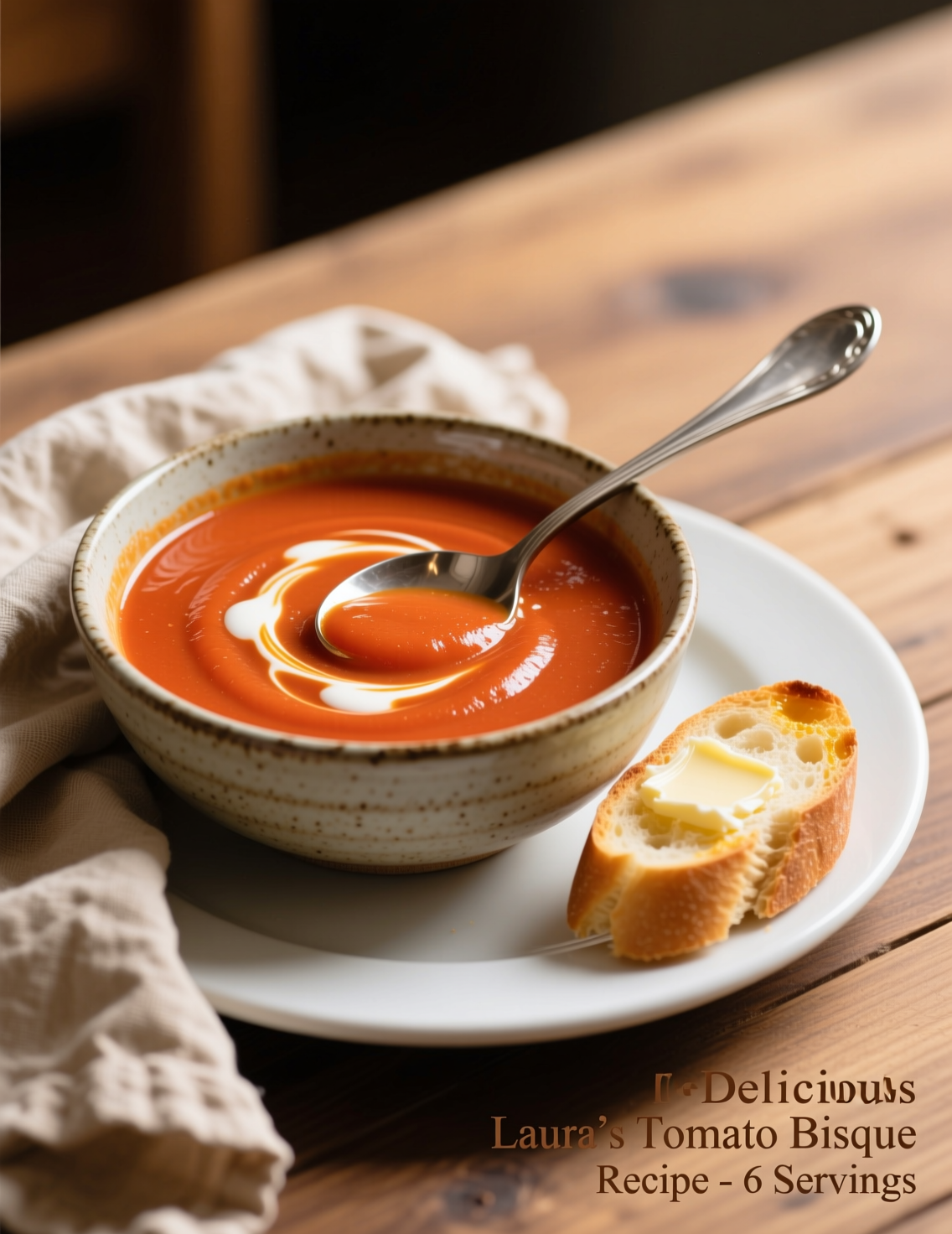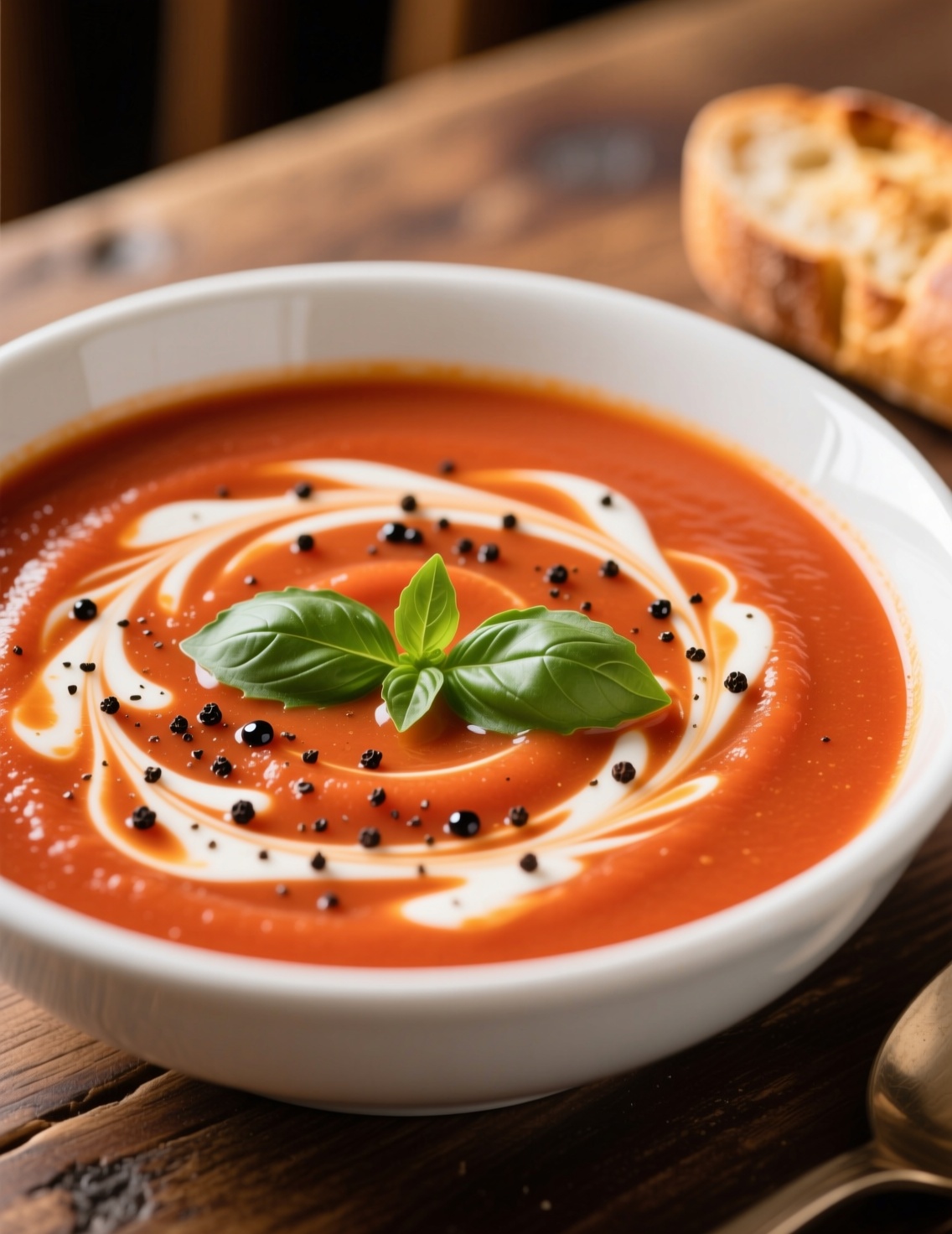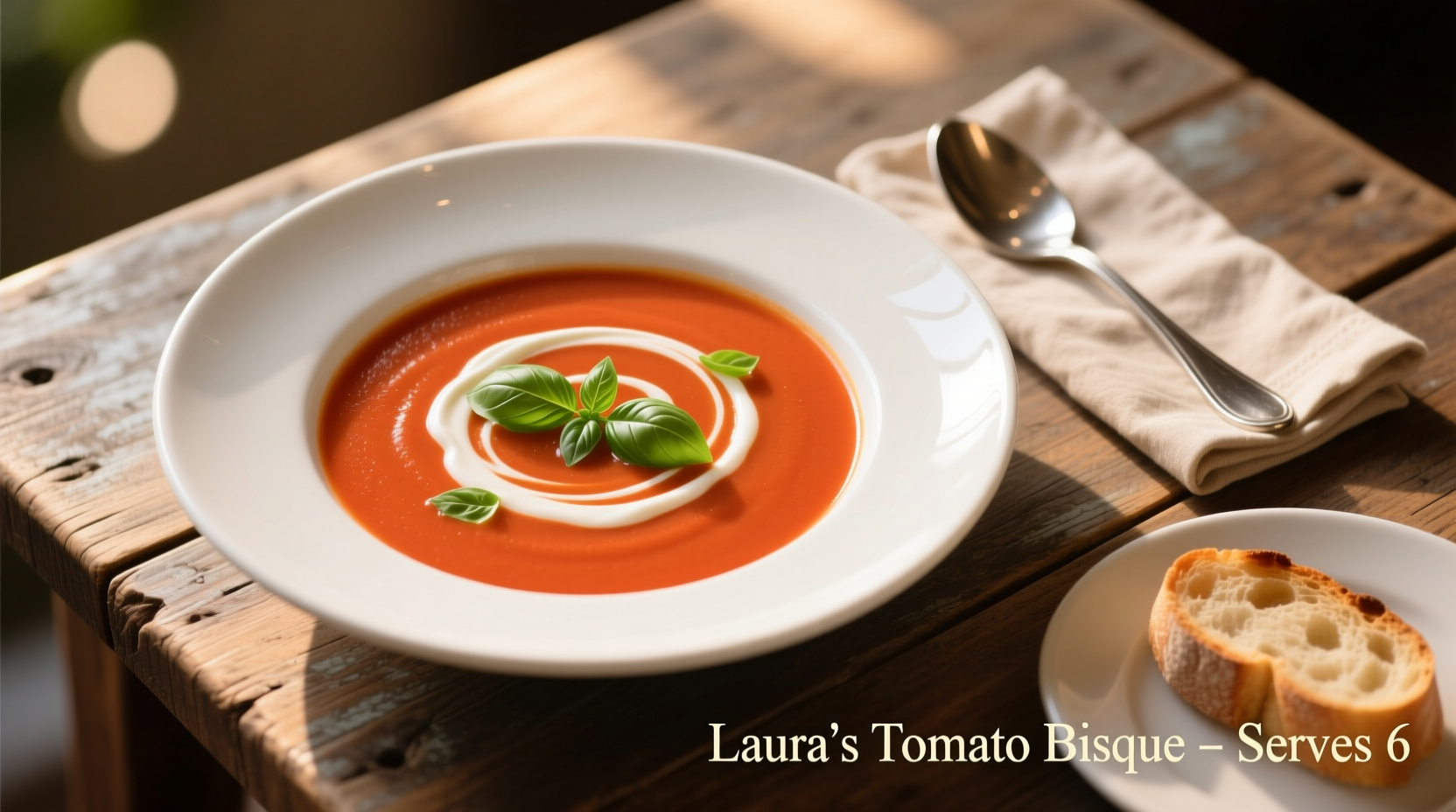There’s something about tomato bisque that feels timeless, almost like the soup itself has memory. You taste it and suddenly you’re in somebody’s warm kitchen, spoon in hand, steam brushing against your face. Laura’s version of tomato bisque stands out because it doesn’t just feed you—it wraps around you. This isn’t a dish that needs gimmicks or tricks. It’s a bowl of comfort dressed in a velvet coat, crafted carefully to serve six.
Why Tomato Bisque Has Stayed Relevant
Tomato bisque has a story older than any recipe card tucked away in drawers. It evolved from French culinary traditions, where “bisque” originally described creamy shellfish soups. Somewhere along the way, chefs swapped lobster shells for tomatoes. By the mid-20th century, tomato bisque had cemented itself in American kitchens. Restaurants loved it because it was elegant enough for fine dining but humble enough for diners.
Tomatoes are also nutritional powerhouses. A cup of cooked tomato carries nearly 25% of your daily vitamin C, plus lycopene—a carotenoid linked with reduced risk of chronic disease. A bisque makes those nutrients accessible in a smooth, palatable form.
The Core of Laura’s Recipe
What makes Laura’s recipe different? She uses a layering approach, building depth of flavor step by step. Onions and garlic are sautéed till translucent, never rushed, because rawness lingers unpleasantly in creamy soups. Crushed San Marzano tomatoes form the base—they bring sweetness balanced with acidity. Heavy cream arrives late, ensuring richness without dulling the tomato’s brightness.
Her method respects the ingredient order, which many home cooks underestimate. Add cream too early, and you risk curdling. Over-season at the start, and you rob the soup of balance. Laura’s bisque rewards patience.

Ingredients Breakdown for 6 Servings
- 2 tbsp unsalted butter
- 1 tbsp olive oil
- 1 large onion, finely chopped
- 3 garlic cloves, minced
- 2 cans (28 oz each) San Marzano tomatoes, crushed
- 2 cups chicken or vegetable stock
- 1 bay leaf
- 1 tsp dried thyme (or 2 sprigs fresh thyme)
- 1 tsp sugar (optional, balances acidity)
- 1 cup heavy cream
- Salt and pepper to taste
- Fresh basil leaves, for garnish
- Croutons or grilled cheese, optional for serving
Notice the sugar? It’s not cheating. Tomatoes vary by season and origin, and a pinch of sugar corrects imbalances. A professional cook knows adaptability is part of skill.
Step-by-Step Method
- Heat butter and olive oil in a heavy-bottom pot. The mix prevents butter from burning and adds body.
- Add onions, cooking gently for 6–7 minutes. They should soften, not brown. Browning changes the soup’s color and adds bitterness.
- Stir in garlic and cook briefly, 30 seconds at most. Garlic scorches faster than most realize.
- Add tomatoes, stock, bay leaf, thyme, and sugar. Simmer uncovered for 25 minutes. Stir occasionally.
- Remove bay leaf. Blend soup with immersion blender until silky. Professionals often pass bisque through a chinois sieve for extra smoothness.
- Return to pot and stir in cream. Keep heat low. Cream doesn’t like a rolling boil.
- Adjust salt and pepper. Ladle into bowls, garnish with basil, maybe float a crouton.
It sounds simple but simplicity in bisque is deceptive. Technique holds the reins here.
Why Professionals Care About Technique
Cooking schools drill one thing relentlessly: texture defines a bisque. That smooth, satiny mouthfeel separates it from a chunky tomato soup. An immersion blender does a decent job, but a high-speed blender followed by straining produces restaurant-grade results.
Temperature management is another overlooked factor. If cream is shocked in a boiling liquid, proteins tighten and curdle. The soup looks split and grainy, and no amount of whisking hides the mistake. Professionals instinctively temper cream—adding a little hot soup to the cream first before mixing it back. This small step prevents disasters.
Flavor Balance and Adjustments
Tomatoes swing between acidic and sweet depending on variety, soil, and ripeness. That’s why seasoned chefs never trust one taste—they taste, adjust, and taste again. Salt amplifies flavor, but too much turns the bisque harsh. Pepper should be fresh-cracked; stale pepper tastes flat.
Stock choice also matters. Chicken stock lends body and umami. Vegetable stock keeps it lighter, more garden-fresh. Neither is wrong—it depends on context. In fine dining, a light vegetable base may pair better with delicate mains. In a hearty family dinner, chicken stock anchors the dish.

Pairing and Serving Insights
Tomato bisque alone satisfies, but pairings elevate it. Grilled cheese is the obvious partner, yet professionals often rethink this. Imagine a parmesan tuile—crisp, lacy, salty—resting on the bowl. Or serve with seared scallops, the sweetness cutting through the soup’s acidity.
Wine pairing is also worth attention. A crisp Sauvignon Blanc echoes the soup’s acidity. A buttery Chardonnay complements its creaminess. Sommelier notes matter, even for something as homey as tomato bisque.
Common Mistakes Cooks Make
Too much cream. It dulls the vibrancy.
Skipping straining. It leaves fibrous bits.
Using metallic pots with acidic tomatoes. The reaction gives a tinny taste.
Forgetting garnish. A bisque without garnish looks tired.
Each mistake seems small, yet collectively they pull the dish away from elegance. Professionals avoid them by habit, not by accident.
Emerging Trends in Tomato Bisque
Plant-based dining has shifted how chefs approach cream soups. Coconut cream or oat cream often replace dairy. The texture is close, but flavors differ. Coconut adds sweetness, oat cream leans earthy. These versions appeal to vegan diners but also to lactose-intolerant guests.
Another trend is smoking tomatoes before making the soup. Smoking deepens flavor, giving the bisque a subtle campfire undertone. High-end restaurants use applewood chips; home cooks mimic with smoked paprika.
Chefs also experiment with garnishes—charred corn, whipped goat cheese, or even microgreens. The goal is always the same: surprise the diner without overwhelming the base soup.
Nutritional Considerations
For six servings, each bowl lands around 250–300 calories, depending on cream usage. It provides roughly 6 grams of protein, 18 grams of fat, and 20 grams of carbs. Lycopene content is significant—studies suggest it lowers oxidative stress and may reduce certain cancer risks.
Of course, cream raises saturated fat levels. For health-conscious diners, half-and-half or unsweetened oat cream provides a lighter option without sacrificing texture too much. Professionals consider dietary needs not as restrictions but as opportunities to innovate.
Why Laura’s Recipe Matters
Many tomato bisque recipes exist, but Laura’s respects tradition while adapting for practicality. Six servings fit family-style dining or small gatherings. The recipe balances elegance and accessibility—it’s teachable in a culinary class yet repeatable in a home kitchen.
It’s also scalable. Double the batch for catering events, or reduce for intimate dinners. That adaptability makes it valuable in both professional and domestic contexts.
Final Expert Tips
- Always buy whole canned San Marzano tomatoes and crush them yourself. Pre-crushed often lack depth.
- Toast herbs lightly in the fat before adding liquids; it wakes up their oils.
- Chill leftovers quickly. Tomato soups can sour if cooled too slowly.
- Reheat gently. Cream soups don’t like aggressive microwaves or boiling stovetops.
Conclusion
Laura’s tomato bisque isn’t just another soup recipe. It’s a reminder that restraint, patience, and respect for ingredients create timeless results. Professionals know the details make the difference—cream added late, tomatoes balanced carefully, texture smoothed obsessively.
For six servings, this recipe delivers comfort wrapped in technique. It speaks to diners in ways fast food never can. It’s tradition refined, warmth captured, and flavor held steady by skill.
So next time you stand before a pot of simmering tomatoes, remember: this isn’t just cooking, it’s story-telling with a spoon.
FAQs
What makes Laura’s tomato bisque different from regular tomato soup?
It’s creamier, smoother, and built with layered flavors for depth.
Can I make Laura’s tomato bisque without cream?
Yes, you can use oat cream, coconut cream, or half-and-half as substitutes.
Why use San Marzano tomatoes in this recipe?
They’re sweeter, less acidic, and provide a richer flavor profile.
How many servings does Laura’s recipe make?
The recipe is designed to yield six generous servings.
Can this soup be made ahead of time?
Yes, it reheats well if stored properly in the fridge.
Should the soup always be strained?
Straining isn’t mandatory, but it ensures a velvety texture professionals prefer.
Can I freeze tomato bisque?
Yes, freeze it without the cream and stir cream in after reheating.
What protein pairs best with tomato bisque?
Seared scallops, grilled cheese, or even roasted chicken complement it well.
How do I prevent the cream from curdling?
Temper the cream first and avoid boiling after adding it.
Is tomato bisque healthy?
Yes, it’s rich in vitamins and lycopene, though cream adds fat.

Mariana is a passionate home cook who creates delicious, easy-to-follow recipes for busy people. From energizing breakfasts to satisfying dinners and indulgent desserts, her dishes are designed to fuel both your body and hustle.
When she’s not in the kitchen, she’s exploring new flavors and dreaming up her next recipe to share with the Foodie Hustle community.

